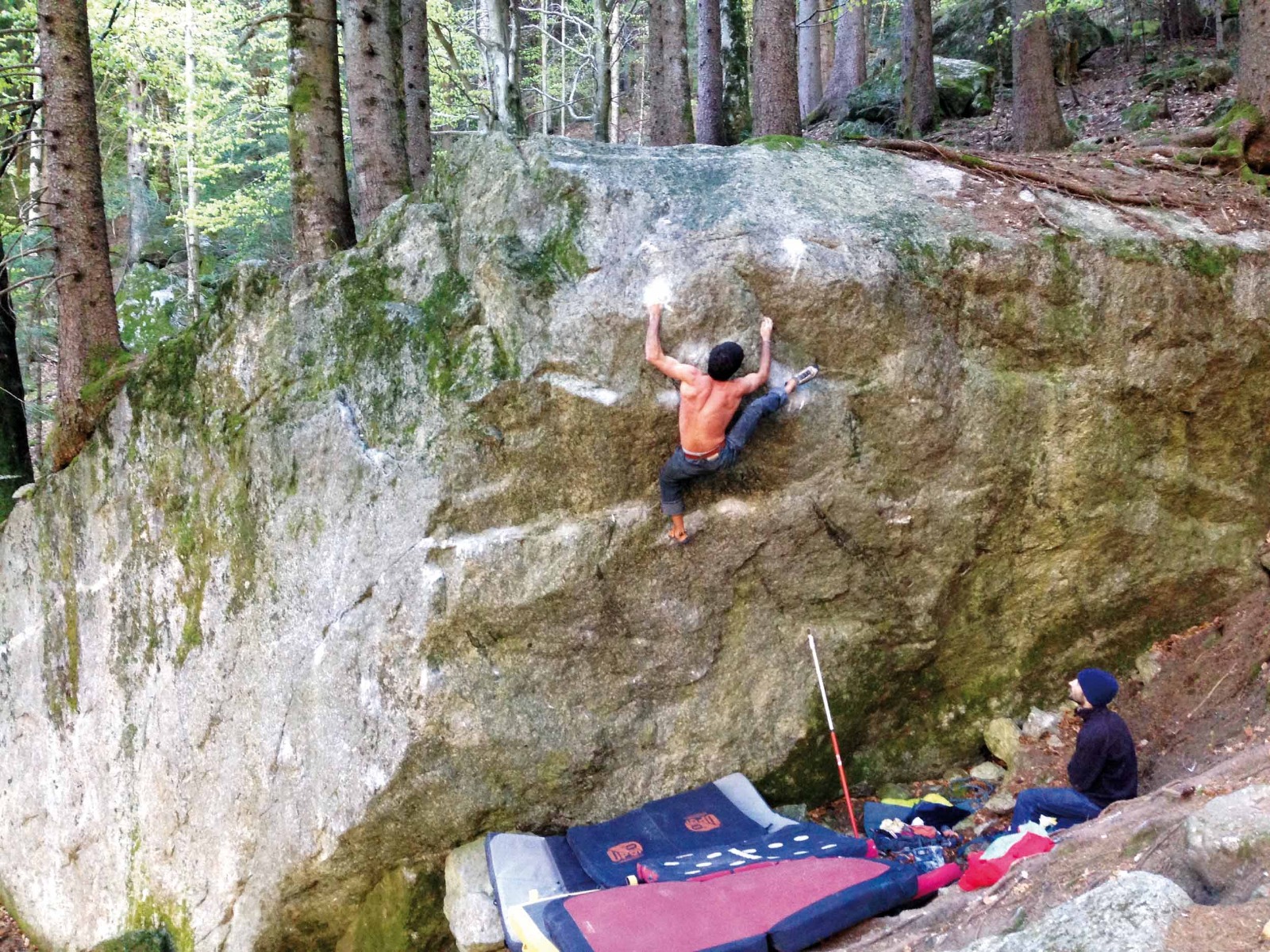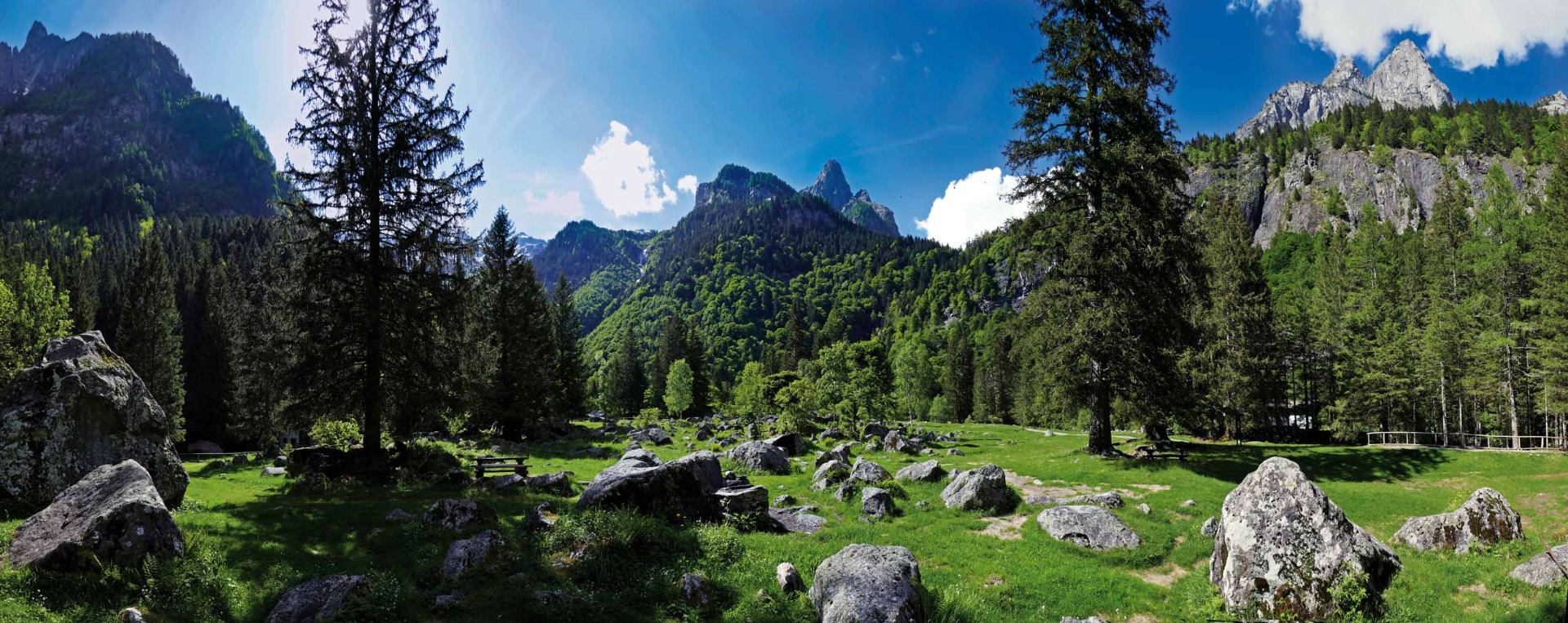Val di Mello has always been an Italian mecca for anyone who loves climbing in all its forms. Its rock, but also the famous winter ice waterfalls, have always been attracting fans of vertical adventures until the area of Sasso Remenno has become the meeting point for the "Sassisti" group. Carrying on a futuristic vision of climbing and mountaineering, where creativity and freedom of expression were the real engine of exploration, they gave life to some wonderful climbing routes, born from the search for the beauty of movement and pure climbing.
The love for rock, for the aesthetics of climbing and the search for a sense of union with the environment lead to the first crack climbing lines, big wall style walls and sport climbing lines that still represent pieces of the history of Italian climbing. [Source Valdimello.it]

Marco Balascini on Little Karma, Bagni di Masino sector (Belvedere), credits Andrea Pavan - Versante Sud
Val di Mello bouldering
Although some boulders already existed and drew to itself some of the strongest boulderers of the 80s (at the time a rarity), it was only in the late 90s and early 2000s that bouldering began to acquire the traits we know now. In 2004 the first Melloblocco was organized, an international event that saw as winners of the first edition Chris Sharma and Stefania De Grandi. From here the increasing popularity of the Valley became unstoppable, attracting boulderers of all nationalities even beyond the days of the event. The colorful duvets and crash pads began to color the valley with punctuality with the arrival of spring and autumn: Val di Mello soon became a holiday destination for families of climbers thanks to its extraordinary logistical comfort. And at each new edition of the Melloblocco, there always were new lines to be attempted.
Five classic sectors
The constantly growing number of sectors and the crazy concentration of boulders to explore have given rise to a particularly voluminous guide that has already seen different editions and updates. MelloBoulder by Andrea Pavan is not only full of details about areas and boulders, but further complemented by the presence of qrcodes that allow you to view the most famous boulders or to locate the parking lots. It is an indispensable tool for anyone who wants to travel days, weekends and weeks of bouldering in Val di Mello.
We have selected - with many difficulties, considering the vast choice - five classic sectors that everyone who has been in Val di Mello at least once in his life has had the opportunity to appreciate.

Michele Dei Cas - Euclide, Credits Andrea Pavan | Versante Sud
Piana del Remenno - Settore Visido
We start from the first area we come across arriving in Filorera. Right in the vicinity of the Multifunctional Center / Casa delle Guide, where you can park your van, have a coffee and cool down with a drink between the bouldering sessions, you can find the first boulders that require practically no approach. The Visido area contains several sectors such as the Tetto diFilorera, I Crotti and Il Tendne dello Yeti. Probably thanks to its unparalleled position, it is one of the most crowded areas, especially in late winter or late autumn, when climbing in full sun is a real pleasure (except for Crotti, mostly in the shade). The group of sectors enclosed in Visido deserves a separate article: not for nothing in Versante Sud guidebook the description of the boulders of this area covers about seventy pages!
These areas, widely appreciated also by families and by those who do not like to walk too much with the pads on their shoulders, also correspond to the most historical sectors: here you will find numerous lines opened in the late 90’s. By sheer coincidence, it is also one of the sectors with the finest and most pleasant grain of all (serizzo), which allows you to climb even for several days in a row. The boulders scattered along the bike path have definitely flat landings, while they can be a little more uneven when climbing on the boulders that are more immersed in vegetation.
Piana del Remenno - Tarzan Sector
Tarzan Sector is another area with a strategic location, located behind the courtyard of the Multifunctional Center. What is fascinating about this sector is that you can have a first overview of the boulders when you are still sipping your coffee, and - more than this - the lines are also beautiful and, in some cases, mentally demanding. Here we find the famous "Il sogno di Tarzan" (stand or sit version), one of the most emblematic passages of the valley, which boasts an opening date of 1992. A little further on in the direction of San Martino, but always clearly visible for its position in the middle of the meadow, there is the boulder of "Waiting for Fred Nicole", a roof that attracts the strongest boulderers.
The Tarzan sector generally requires a good level of climbing, although there are some shy "warm-up" passages. The rock is however excellent and encourages anyone to try these lines that represent the very essence of bouldering.
Piana del Remenno - Sasso Remenno
With the area of Remenno we close the triad of the sectors located in "La Piana" that we decided to include in this short presentation. There are at least as many other sectors around here that are worth a visit, or that include in their list some historical lines. However, we chose to talk about the Remenno both for the amount of impressive boulders, both for the historicity that the Sasso Remenno brings with it: here were written important pages of the history of Italian climbing.
Wandering among the boulders that are scattered around the largest monolith in Europe, you can admire - and maybe try - some super classics whose echo has certainly reached any boulderer (who has already been here or not). Just to name a few, you can find here Il Masso di Goldrake, but also the super hard Unità di Produzione, without forgetting Il Sogno di Tano: these are just some of the pearls that you can find within a few meters. But don't worry: there is so much rock that there are lines for all levels, and fun is guaranteed for everyone.
Val di Mello - Melloblocco sector
When arriving in San Martino, the last town where we can find coffee, refreshments for the day and souvenirs, you can continue towards Bagni di Masino or towards Val di Mello. This last sector also has a particularly historical value, having been explored already during the 70s and 80s. To be more precise, in Melloblocco sector we find some super classics lines: the homonymous Melloblocco boulder, the most striking example, but also the legendary Zero in Condotta or the five-star Skateboarder line.
A lot of sectors in Val di Mello area are located on private land: we recommend you to consult the guidebook to get all the relevant information, especially if you are considering climbing in late spring, when the owners cut the forage. Unlike the Piana del Remenno, where climbing in full sun in the warmer months can be a titanic feat, climbing in Val di Mello in summer is not entirely impossible, although you will certainly not find the best conditions of the year. If you are thinking of visiting the different areas of Val Masino on a mini holiday, do not forget that Val di Mello is the sector with the most painful and sharp grain, and could compromise the health of the skin of the hands for the days to follow.

Bagni di Masino - Claudio Raboni
Bagni di Masino - Belvedere sector
Contrary to the more historic Val di Mello, Bagni di Masino represent a more recent discovery (by the way we are talking about the first sporadic visits in the 90s) that has beeb fully enhanced on the occasion of several editions of Melloblocco in the 2000s. Similarly to Val di Mello, it allows you to climb even when temperatures become inaccessible in La Piana, especially if you consider the boulders more immersed in the woods.
Belvedere is one of the most windy sectors thanks to the vegetation that shelters the boulders from the sun of late spring and early summer. The beauty of the lines is also reinforced by the height of the boulders, which allows a development and a variety of movements absolutely unique; the guide reminds us to always control the way down before venturing on mentally challenging boulders. Bagni di Masino also represent a good compromise between rock grip and abrasiveness: it does not have the super fine grain of some areas of La Piana, but not even the sharp crystals of Val di Mello.
Looking forward to the Val di Mello? Make sure you have a copy of MelloBoulder with you!
